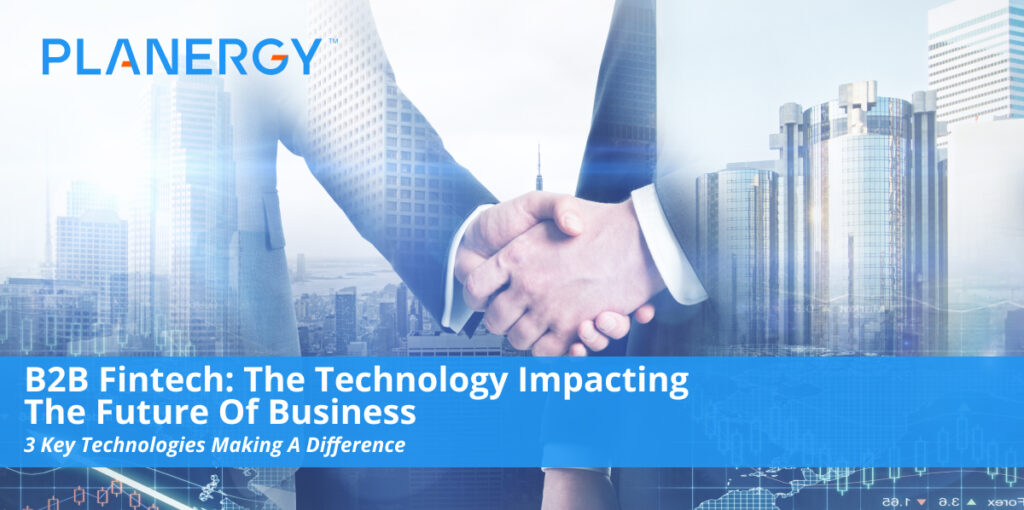In recent years, consumer fintech has grown in popularity. Why? These consumer fintech startups have vastly improved the customer experience across a variety of financial applications.
For instance, Intuit, the company behind Quickbooks and TurboTax, purchased Credit Karma for $7.1 billion in 2020, and PayPal purchased Honey (the coupon code finder app) in 2019.
And it doesn’t end there. 6% of U.S. adults with a checking account are now using a challenger Bank like Chime or Current as their primary bank instead of relying on industry giant financial institutions like Wells Fargo and JPMorgan Chase.
It’s now easier than ever for consumers to get bank accounts with debit cards, without going the traditional checking account route or relying on a credit union.
Until recently, the spotlight has been on consumer fintech but the business-to-business (B2B) fintech space is starting to take center stage.
B2B fintech as we know it today actually began 20 years ago, with companies that were focused just on two core areas: banking as a service and payments. The most notable consignee to come out of the first wave was PayPal.
The company was founded at the beginning of the internet operating on a B2B2C model by embedding at the point-of-sale with merchants and enabling companies to conduct transactions with those merchants effortlessly, without exposing their credit card information.
The company now has a market cap of more than $230 billion. Though it didn’t remove the need for traditional banks, it did quite a bit to streamline payment processes and made for better payment solutions.
In the 2010s, fintech 2.0 emerged with the definition expanding. Within the core fintech, we saw banking as a service and payments continue to grow with companies like afterpay and square. Then it continued to grow with the increase of lending-focused fintech companies like Lending Club and e-commerce infrastructure like Shopify.
In the 2020s, we’re sure to see fintech 3.0 expand even further to include major players in the fraud, risk, and identity areas – many of which are already in the works. It’s also expected that we’ll see growth and big winners in many fintech adjacent areas like privacy, security, and compliance.
Today’s B2B fintech startups are common in the lending space, as well as banking as a service – like software as a service or saas, but with banking. Businesses like Klarna, Fundbox, Affirm, and Kabbage are making it easier for people to manage cash flow.
By offering businesses working capital loans and the ability to receive money for services that consumers then pay back in four payments, these lenders are using financial technologies to change the entire ecosystem, without requiring businesses or consumers to rely on traditional credit.
Giving consumers the flexibility to make payments on purchases is especially helpful during the pandemic when there is so much struggle. That is a major reason why these companies continue to do so well.
Let’s take a closer look at the major technologies that impact B2B fintech.
FinTech is here to stay, and we can expect to see technology continuing to influence B2B (and B2C) FinTech for the foreseeable future.
Big Data and Machine Learning
According to SAS, “big data” is data that is so large, fast, or complex that it’s difficult or impossible to process with traditional methods.
The act of storing and accessing large amounts of information for analytics has been around for a long time but the concept of Big Data only started to gain momentum in the early 2000s when an industry analyst started to articulate the mainstream definition using the three V’s: volume, velocity, and variety.
- Volume: Businesses gather data from a variety of sources such as social media, smart devices, business transactions, equipment, and videos, and more. In the past, storing it would have been difficult, but cheaper storage on cloud platforms has made it easier.
- Velocity: As the Internet of Things (IoT) continues to grow, data comes in two companies at an unprecedented speed and has to be handled in a timely manner. Using RFID tags, smart meters, and sensors drives the need to handle these massive amounts of data in near real-time.
- Variety: Data comes in a variety of formats from structured and numeric data in databases, to unstructured data in emails, video, audio files, financial transactions, and more.
SAS also considers two more Vs:
- Variability: As if velocity and variety of data weren’t enough, data flow is often unpredictable because it changes often and varies greatly. Businesses have to know when something is trending in social media and how to manage seasonal, and event-triggered peak data loads.
- Veracity: Veracity refers to data quality. Because data comes from so many different sources, it’s difficult to link, match, and transform data from one system to another. Businesses have to be able to connect and correlate relationships and hierarchies with multiple data linkages, otherwise, the data gets out of control and becomes unusable.
Data is everywhere these days, and companies of all sizes are constantly inundated with massive amounts of it. In the past, businesses relied on trained data scientists and analysts to harness the information and convert it into analytics and insights poor decision-making. It played an important role in business intelligence.
Today, however, big data technology and machine learning, also known as predictive analytics, is available to help. And today’s security tools help to protect financial data.
Research shows that one-third of respondents are aware of big data and machine learning in the B2B fintech industry and adoption continues to increase. According to the IDC, worldwide revenue for big data and business analytics was expected to surpass $203 billion by 2020.
Thanks to this technology, we can analyze historical data to spot trends and make predictions.
Why it’s useful in a variety of industries and applications. Particularly in B2B fintech, it can be used to predict market risk, reduce fraud, play a potentially fraudulent transaction until a human steps in to make a decision, forecast financial trends, and more.
It can also produce actionable Insight from advanced reporting in data analytics. Ultimately, it gives you in-depth visibility so that C-suite executive members of the company can easily see strategic insights.
Artificial intelligence (AI)
According to IBM, the term artificial intelligence refers to “any human-like intelligence that is exhibited by a computer, robot, or other machine.”
This refers to a computer or machine’s ability to mimic the abilities of the human mind – from learning through examples and experience, understanding and responding to language, making decisions, recognizing objects, etc. and combining these with other capabilities to perform the same function as humans may perform such as driving a car or greeting a customer.
Data shows that people are most familiar with AI as an emerging technology. Nearly half of the people surveyed are aware of its use in fintech applications such as AP automation like that provided by PLANERGY.
Respondents are most likely familiar with AI because of the revolutionary change it has created across a variety of industries. In fintech, the technology creates deep personalization that helps build consumer relationships in real time.
Data shows that many B2B companies are using AI to improve operations including their financial services. 83% of businesses surveyed cite it as a strategic priority.
Using AI can boost productivity by up to 40% because it automates the mundane tasks that consume valuable time. Through automation, companies can reduce hiring costs while also freeing the staff for more strategic and fulfilling responsibilities.
Nearly 25% of customer experience officers (CXOs) believe AI will have the biggest impact on their organization within the next 5 years. 84% of businesses say that AI will make it easier for them to sustain or obtain a competitive advantage and 75% of them say AI technology will allow them to expand into new businesses.
Blockchain
According to Built In, blockchain technology is defined as a “decentralized distributed ledger that records the provenance of a digital asset”. By inherit design, the data on the blockchain is unable to be modified which makes it a legitimate disrupter for payment industries, cybersecurity, and Healthcare.
The blockchain is a distributed network that can record payments and other transactions quickly, in a transparent, verifiable, and permanent way. It makes use of cryptocurrencies like Bitcoin as the exchange medium. Among B2B fintech users, there is limited knowledge of the blockchain’s ability.
There are a variety of applications, but compared to AI, it is much less known in the fintech world. Only about 25% of respondents are familiar with how it is used in fintech.
Even with the technology available, U.S. businesses are owed over $3 trillion dollars in accounts receivable on any given day. Most small businesses are lost in a confusing world of payment providers and merchants can choose from a variety of platforms that are difficult to distinguish from one another.
Many small businesses aren’t getting paid on time and deal with fraud risk. Independent software vendors and small merchants lean toward tools that are easy to implement thereby opting for simplicity over speed and profit.
As the B2B FinTech industry continues to grow, it will be easier for even the smallest of businesses to implement automated workflows and procurement-to-pay processes that larger organizations currently use. This will make it easier for them to compete with larger businesses, and help to level the playing field.




